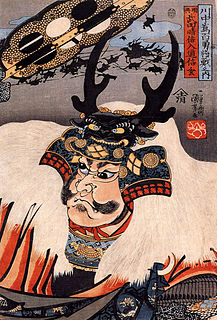
Tokugawa Ieyasu was the founder and first shōgun of the Tokugawa shogunate of Japan, which effectively ruled Japan from the Battle of Sekigahara in 1600 until the Meiji Restoration in 1868. Ieyasu seized power in 1600, received appointment as shōgun in 1603, and abdicated from office in 1605, but remained in power until his death in 1616. His given name is sometimes spelled Iyeyasu, according to the historical pronunciation of the kana character he. Ieyasu was posthumously enshrined at Nikkō Tōshō-gū with the name Tōshō Daigongen (東照大権現). He was one of the three unifiers of Japan, along with his former lord Nobunaga and Toyotomi Hideyoshi.

The Azuchi–Momoyama period is the final phase of the Sengoku period in Japan. These years of political unification led to the establishment of the Tokugawa shogunate. It spans the years from c. 1573 to 1600, during which time Oda Nobunaga and his successor, Toyotomi Hideyoshi, imposed order upon the chaos that had pervaded since the collapse of the Ashikaga shogunate.
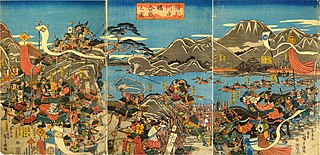
The battles of Kawanakajima were fought in the Sengoku period of Japan between Takeda Shingen of Kai Province and Uesugi Kenshin of Echigo Province in the plain of Kawanakajima, Nagano, "the island between the rivers", in the north of Shinano Province. The location is in the southern part of the present-day city of Nagano. Five major battles took place there: Fuse in 1553, Saigawa in 1555, Uenohara in 1557, Hachimanbara in 1561, and Shiozaki in 1564. The best known and most severe among them was fought on October 18, 1561, and was only fought in the heart of the Kawanakajima plain, thus being the "battle of Kawanakajima". The battles were fought after Shingen conquered Shinano, expelling Ogasawara Nagatoki and Murakami Yoshikiyo, who subsequently turned to Kenshin for help. The battles became one of the most cherished tales in Japanese military history, the epitome of Japanese chivalry and romance, mentioned in epic literature, woodblock printing and movies.
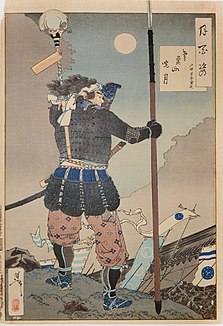
The Battle of Nagashino took place in 1575 near Nagashino Castle on the plain of Shitarabara in the Mikawa Province of Japan. Takeda Katsuyori attacked the castle when Okudaira Sadamasa rejoined the Tokugawa, and when his original plot with Oga Yashiro for taking Okazaki Castle, the capital of Mikawa, was discovered.

Sanada Masayuki was a Japanese Sengoku period lord and daimyō. He was the head of Sanada clan, a regional house of Shinano Province, which became a vassal of the Takeda clan of Kai Province.

Uesugi Kagekatsu was a Japanese samurai daimyō during the Sengoku and Edo periods.
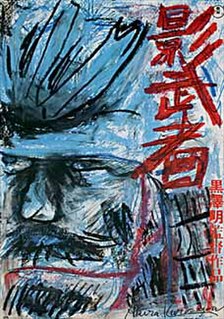
Kagemusha is a 1980 jidaigeki film directed by Akira Kurosawa. In Japanese, kagemusha is a term used to denote a political decoy. It is set in the Sengoku period of Japanese history and tells the story of a lower-class criminal who is taught to impersonate a dying daimyō to dissuade opposing lords from attacking the newly vulnerable clan. The daimyō is based on Takeda Shingen, and the film ends with the climactic 1575 Battle of Nagashino.
Ogasawara Nagatoki (小笠原長時) was a Japanese samurai daimyō of Shinano Province in the Sengoku period.
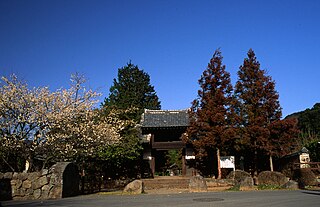
Takeda Nobutora was a Japanese daimyō who controlled the Province of Kai, and fought in a number of battles of the Sengoku period.

The Takeda clan was a Japanese clan active from the late Heian period until the late 16th century. The clan was historically based in Kai Province in present-day Yamanashi Prefecture. The clan was known for their honorable actions under the rule of Takeda Shingen, one of the most famous rulers of the period.

Iwamura Castle was located in the southeastern area of Mino Province in Japan. Its ruins can be found in the modern-day town of Iwamura in Ena District, Gifu Prefecture.

Ueda Castle is a Japanese castle located in Ueda, northern Nagano Prefecture, Japan. At the end of the Edo period, Ueda Castle was home to a junior branch of the Matsudaira clan, daimyō of Ueda Domain, but the castle is better known for its association with the Sengoku period Sanada clan. It was also called Amagafuji-jō or Matsuo-jō.
Sanada Nobutsuna was a Japanese samurai of the Sengoku period. He was born in Matsuo castle and was the eldest son of Sanada Yukitaka, a castle lord in Shinano Province who, by the time of his son's coming-of-age, had pledged his loyalty to the Takeda. During his coming-of-age ceremony, therefore, Sanada Nobutsuna was granted the shin (信) character from Takeda Shingen's name and took the name of Nobutsuna (信綱).
The 1554 siege of Kannomine was one of many battles fought in Takeda Shingen's campaign to seize control of Shinano Province. This took place during Japan's Sengoku period; Shingen was one of many feudal lords (daimyōs) who battled to gain land and power.

Kakegawa Domain was a feudal domain under the Tokugawa shogunate of Edo period Japan. The domain was centered at Kakegawa Castle in Tōtōmi Province, in what is now the city of Kakegawa, Shizuoka.

Minowa Castle is a castle located in Takasaki, Gunma Prefecture, Japan.
Takeda Nobuzane (武田信実) more commonly known as Kawakubo Nobuzane was a younger half-brother of Takeda Shingen, a preeminent daimyō who vied for the control of Japan in the late stage of Sengoku, the "warring states" period. He was also called Kawakubo Nobuzane because he was raised in Kawakubo village.

Suwa Domain was a feudal domain under the Tokugawa shogunate of Edo period Japan. It is located in Shinano Province, Honshū. The domain was centered at Takashima Castle, located in what is now part of the town of Suwa in Nagano Prefecture. It was also known as Takashima Domain.
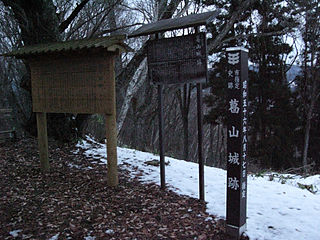
The Siege of Katsurayama in March 1557 was fought between the forces of the Japanese daimyō Takeda Shingen and Uesugi Kenshin as part of the Kawanakajima campaigns. Katsurayama castle was a strategically vital Uesugi stronghold in the contested Shinano Province and, when it was isolated from reinforcements due to late snow in early 1557, the Takeda clan used this opportunity to attack it. Although the castle garrison, consisting of the Ochiai clan and elements of the Murakami clan, defended Katsurayama furiously, the Takeda forces under Baba Nobuharu eventually stormed into the castle. Most of the garrison was killed in combat, while the families of the defenders committed mass suicide and the castle was burned to the ground.

